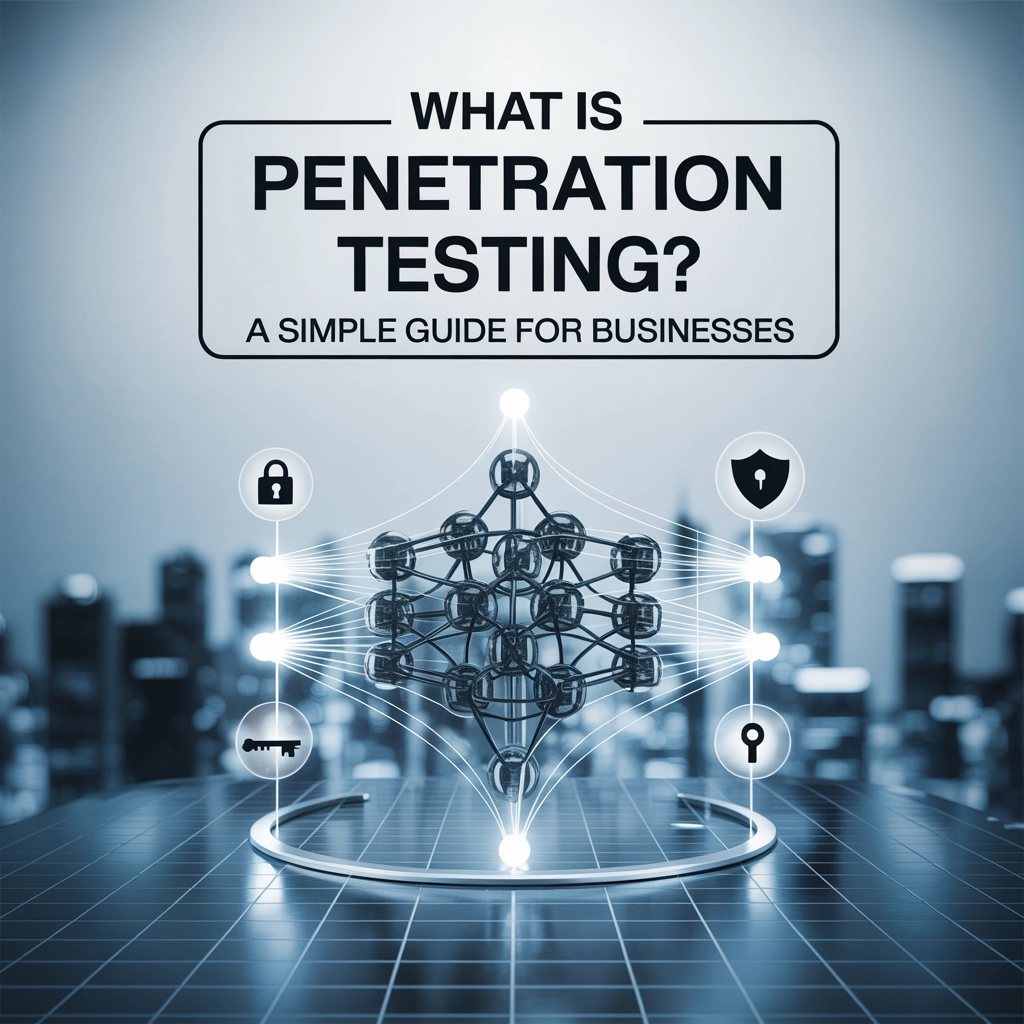Penetration testing, commonly known as "pen testing," is one of today’s most effective strategies for businesses aiming to stay ahead of cyber attackers. In the cybersecurity space, penetration testing is an authorised, simulated attack carried out by experts to discover and prove weaknesses in your business’s digital environment. Instead of waiting for criminals to strike, you let professionals mimic an attack, then provide you with a roadmap to defences that actually work.
This article breaks down what penetration testing is, why it is crucial for business security, its main types and process, plus the most impactful benefits. Whether you are new to the term or looking to refresh your understanding, this guide provides clear insights for business leaders navigating the modern threat landscape.
What Is Penetration Testing?
At its core, penetration testing is a controlled cyber assault on your business systems and networks, performed by trained ethical hackers with your permission. Rather than relying on theory, pen testing puts your security measures to the test in realistic conditions. By attempting to access your critical data and assets using the techniques attackers would use, penetration testers expose vulnerabilities that automated scans might miss.
Penetration testers finish the job with a comprehensive report, grading the severity of each weakness found and offering prioritised steps to fix them. Think of it as a security ‘health check’, it addresses not just the existence of vulnerabilities, but how they can actually be abused in practice.
For a video summary, see: What is Penetration Testing?
Why Is Penetration Testing Vital for Businesses?
The threat of cybercrime is now a daily reality for every business, from start-ups to established enterprises. Phishing scams, ransomware, and targeted network attacks do not discriminate based on company size. In fact, attackers often see small to medium businesses as easier prey. As ransomware payouts and data breach costs continue to soar, merely having basic security tools is no longer considered safe practice.
Penetration testing addresses this head on by:
- Providing real-world evidence of how your defences hold up under attack
- Identifying hidden vulnerabilities in software, networks, and human procedures
- Meeting industry and regulatory requirements for ongoing security evaluation
- Giving business leaders actionable insight into risk reduction strategies
Automated scans are useful for quickly spotting well-known vulnerabilities, but they can produce overwhelming reports filled with false positives and unproven risks. Penetration testing steps far beyond, delivering a proven and actionable remediation plan based on real attack scenarios.
The Main Types of Penetration Testing
Pen testing is not a one-size-fits-all solution. Security experts tailor the scope to fit business priorities, compliance needs, and technical realities. Here are the most common types of penetration testing:
1. White Box Testing
In white box pen testing, the tester is given full information about your infrastructure. This can include internal documentation, source code access, and system credentials. The idea is to mirror the capabilities of an insider with in-depth knowledge. White box tests are excellent for deep-rooted security audits, finding logic errors, and assessing internal risks.
2. Black Box Testing
In black box testing, the tester knows nothing about your system apart from the public-facing domain or company name. This simulates how a real-world hacker would approach your business, scanning for externally visible vulnerabilities and entry points. Black box tests are ideal for measuring your external perimeter and evaluating your defences from an outsider’s perspective.
3. Grey Box Testing
A grey box test strikes a balance, with testers having partial knowledge of the environment. This method simulates the scenario where an attacker has gained limited access (for example, through a compromised low-level account) or some intelligence through open-source research.

Each type can be applied to different targets, such as:
- External Network Infrastructure: Firewalls, web servers, email gateways
- Internal Networks: Employee access points, file shares, internal databases
- Web and Mobile Applications: Websites, APIs, apps handling customer or financial data
- Wireless Networks: Wi-Fi systems within your physical premises
- Social Engineering: Testing staff response to phishing and impersonation attempts
The Penetration Testing Process: A Step-by-Step Guide
Penetration testing is carefully structured to minimise business disruption while delivering real value. Here is how a modern penetration test typically unfolds:
1. Reconnaissance
The process starts with information gathering. Testers scan public and private sources to map the target’s digital footprint, building a picture of potential attack surfaces. This includes everything from internet-facing servers to employee email addresses and application endpoints.
2. Scanning & Enumeration
Armed with reconnaissance data, testers use scanning tools and manual techniques to identify live hosts, open ports, and running services. Enumeration goes deeper, uncovering misconfigurations, outdated software versions, and hidden entry points. These steps lay the foundation for identifying vulnerabilities to exploit.
- Learn more about port scans: What Is Port Scanning?
- Discover enumeration methods: What Is an ARP Scan?
3. Exploitation
Here is where pen testing gets hands-on. Testers attempt to exploit verified vulnerabilities using specialist tools and scripts. This phase demonstrates the practical risk to your business: can an attacker gain unauthorised access, escalate their privileges, or exfiltrate sensitive data?
Real-world tools like Nmap, Kali Linux, Burp Suite, and SQLMap are commonly used in this phase, closely mirroring the methods of criminal hackers.
4. Reporting & Recommendations
The test concludes with a robust report detailing every vulnerability found, proof of exploitation where applicable, and a clear action plan for remediation. Reports will typically rank vulnerabilities based on their risk level, making it easier for teams to prioritise the most pressing issues. EJN Labs, for instance, specialises in translating even highly technical findings into straightforward, business-focused recommendations.

What Are the Business Benefits of Penetration Testing?
Penetration testing represents a proactive investment in your company’s digital future. Here is how businesses benefit:
- Minimised Risk of Breaches: By identifying weak points before attackers do, you drastically reduce the odds of a breach.
- Informed Security Spending: Instead of pouring budget into unnecessary tools, focus on shoring up real, proven vulnerabilities.
- Operational Continuity: Stay ahead of attackers to avoid business downtime, regulatory fines, and damage to client trust.
- Mandatory Compliance: Many industries (finance, healthcare, SaaS and more) require regular penetration testing for regulatory certification.
- Enhanced Reputation: Customers and partners are more likely to trust organisations that demonstrate a mature approach to security.
- Prepared Response Teams: Pen tests can act as a live-fire drill, testing how quickly your IT and security teams can detect and contain an incident.

Key Considerations When Choosing to Pen Test
- Frequency: Best practice is to conduct penetration tests at least annually, or after major changes to systems or infrastructure.
- Expertise: Ensure your testers use the same advanced techniques real attackers would use, not just automated scans.
- Ethics and Scope: Always work with reputable security partners who provide clear engagement terms and ethical boundaries.
- Remediation Support: The value of penetration testing is realised only if you act on the findings. Work with partners like EJN Labs who also offer post-test remediation guidance.
For helpful advice tailored to your business needs, or a trusted quote for your next penetration test, visit EJN Labs.
Strengthen Your Security Posture Today
Penetration testing is not a luxury for big businesses, it is an essential for anyone relying on digital infrastructure. By identifying and addressing vulnerabilities proactively, you gain a strategic edge against attackers, meet your compliance responsibilities, and build customer trust in your brand.
Ready to get started? See more about our penetration testing services at EJN Labs or reach out for a free consultation.
For more detailed articles and practical resources on cybersecurity, visit the EJN Labs blog.











Leave a Reply